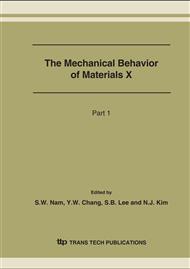p.1101
p.1107
p.1115
p.1121
p.1125
p.1129
p.1133
p.1137
p.1141
Residual Stress Estimation with Identification of Stress Directionality Using Instrumented Indentation Technique
Abstract:
The instrumented indentation technique (IIT) has recently attracted significant research interest because it is nondestructive and easy to perform, and can characterize materials on local scales. Residual stress can be determined by analyzing the indentation load-depth curve from IIT. However, this technique using a symmetric indenter is limited to an equibiaxial residual stress state. In this study, we determine the directionality of the non-equibiaxial residual stress by using the Knoop indentation technique. Different indentation load-depth curves are obtained at nonequibiaxial residual stresses depending on the Knoop indentation direction. A model for Knoop indentation was developed through experiments and theoretical analysis.
Info:
Periodical:
Pages:
1125-1128
Citation:
Online since:
August 2007
Authors:
Price:
Сopyright:
© 2007 Trans Tech Publications Ltd. All Rights Reserved
Share:
Citation:


